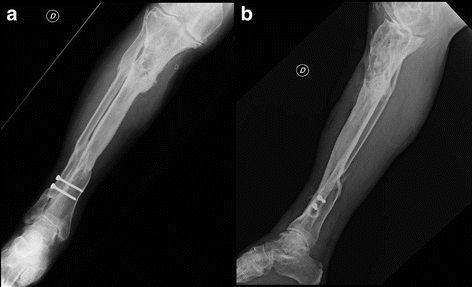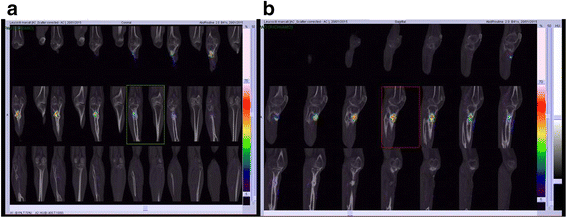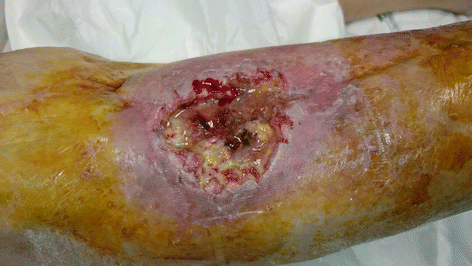Squamous cell carcinoma in chronic osteomyelitis: a case report and review of the literature
- PMID: 27491284
- PMCID: PMC4973539
- DOI: 10.1186/s13256-016-1002-8
Squamous cell carcinoma in chronic osteomyelitis: a case report and review of the literature
Abstract
Background: Chronic osteomyelitis is a challenging problem, and malignant transformation is a rare occurrence. We report a case of a patient with squamous cell carcinoma arising from an osteomyelitic hotbed and discuss through a literature review the etiopathogenesis, diagnosis, and treatment of this lesion.
Case presentation: A 69-year-old Italian man had sustained an exposed tibial fracture 40 years ago during a road accident, for which he had undergone various surgical osteosynthesis treatments with multiple antibiotic therapies. He presented to our hospital because of recurrence of a fistula at the proximal third of the anterior region of the tibia. For 2 months, we treated the lesion with antibiotics, and local medication with curettage. We saw no evidence of lesion improvement, and we advised the patient to undergo a knee amputation, which he refused. The alternative we chose was a surgical toilet of the osteomyelitic hotbed and used bioglass as a bone substitute. After 2 months of follow-up, we noticed a fulminating, budding formation in the area of the surgical wound that turned out to be a squamous cell carcinoma on biopsy. The patient again refused the amputation and underwent a wide-margin surgical debridement. After 2 months, the carcinoma recurred, and an above-the-knee amputation was performed.
Conclusions: Our experience with this case indicates that amputation is the most appropriate treatment for squamous carcinoma occurring in patients with chronic osteomyelitis. To avoid risks of lymphonodular and organ metastasization, this radical surgical procedure should not be delayed. Early diagnosis and timely therapy can prevent amputation only in selected cases. Surgeons who treat osteomyelitis and chronic wounds should be aware of the risk of tumor degeneration. Squamous cell carcinoma associated with chronic osteomyelitis has a low-grade malignancy, but implications of lymphonodular involvement and organ metastasis should not be excluded.
Keywords: Amputation; Bioglass; Chronic wound; Exposed fracture; Osteomyelitis; Squamous cell carcinoma; Tibia.
Figures







References
-
- American Cancer Society. Basal and squamous cell skin cancer stages. http://www.cancer.org/cancer/skincancer-basalandsquamouscell/detailedgui.... Accessed 21 May 16.
-
- Celsus AC. De Medicina. Chapter XXVI.
-
- Johnston RM, Miles JS. Sarcomas arising from chronic osteomyelitic sinuses. J Bone Joint Surg Am. 1973;55:162–8. - PubMed
Publication types
MeSH terms
LinkOut - more resources
Full Text Sources
Other Literature Sources

